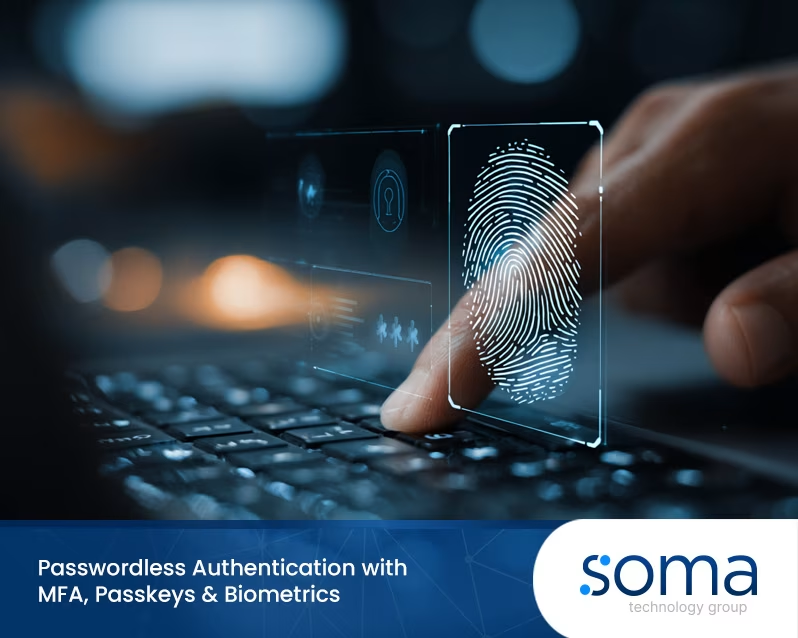.webp)
Data Loss Protection Strategies: A Guide to Data Loss Prevention (DLP)
You’ve likely heard it before: your data is one of your most valuable assets. Yet, for small and mid-sized business owners like you, the concept of data loss can seem distant until it happens. When it does, the reality hits hard—losing sensitive data isn’t just a temporary setback; it can cripple operations, tarnish your reputation, and cost you thousands in recovery and lost opportunities.
This isn’t just another IT problem. This is the survival of your business. So, how do you ensure data loss protection?
What is data loss?
Data loss is the unintended or accidental deletion, corruption, or compromise of information, making it unavailable for its intended use. This can happen when files are deleted, software malfunctions, or, in severe cases, when cybercriminals steal or erase your critical information.
Your business handles sensitive data daily—from client records and financial transactions to internal documents. When this information is lost, it can lead to legal complications, customer distrust, and severe financial repercussions. Understanding what causes data loss can help you mitigate it effectively.

Common causes of data loss
Many business owners underestimate the various ways data can be compromised. Here are some common culprits:
Human error
Accidentally deleting important files or misplacing data can happen to anyone. For businesses, this can lead to significant disruptions. Imagine a company accidentally losing a client’s contract due to a mistaken deletion, leading to potential legal and financial issues.
Another common scenario is a marketing team misplacing critical campaign data, resulting in delays or missed opportunities. Such incidents are among the leading causes of data loss, emphasising the need for robust data management and backup solutions.
Hardware failure
Hard drives crash, servers malfunction, and without proper backups, your important data goes with them. For businesses, this can mean losing critical financial records, customer information, or project data. Imagine a retail company unable to access its inventory database, causing disruption in sales and fulfilment.
Or consider a law firm losing access to case files, leading to potential breaches of client confidentiality. Investing in reliable backup solutions and disaster recovery plans is crucial for protecting your business's operational continuity and reputation.
Cybersecurity threats
Data breaches, ransomware attacks, and data exfiltration pose significant threats to the security of sensitive information. For example, a data breach at a retail company could lead to the exposure of customer credit card details, causing financial losses and damaging the company's reputation. Ransomware attacks on hospitals can disrupt operations by locking access to patient records until a ransom is paid, potentially putting patient care at risk.
In the case of data exfiltration, a tech company might face the unauthorised transfer of proprietary software code, compromising its competitive advantage in the market. These scenarios highlight the critical need for businesses to implement robust cybersecurity measures to protect their sensitive data.
Software corruption
Misconfigurations, bugs, or unexpected shutdowns can corrupt data, leaving it unusable. For instance, a retail business might experience a database misconfiguration that alters inventory records, leading to inaccurate stock levels and impacting sales.
Similarly, a software bug in a financial company could cause errors in transaction records, disrupting client accounts and trust. Unexpected system shutdowns in a healthcare organisation might result in the loss of critical patient records, hindering treatment and compliance efforts. These examples highlight the importance of robust data protection and recovery strategies across various industries.
Natural disasters
While not common, events like fires or floods can destroy data stored on physical servers, posing significant risks to businesses. For instance, a fire in an office building could damage servers, leading to the loss of critical financial records and customer databases.
Similarly, a flood resulting from a natural disaster could submerge server rooms, wiping out years of valuable research data for a tech company. Businesses must consider these possibilities and implement robust data backup and recovery plans to safeguard their information against such unforeseen events.

What is data loss protection?
Data loss protection, commonly known as data loss prevention (DLP), refers to a set of strategies, tools, and processes designed to detect and prevent unauthorised access, sharing, or destruction of sensitive information. Think of it as a protective layer over your data, ensuring that it doesn’t slip through the cracks or fall into the wrong hands.
DLP solutions can detect sensitive data control data at rest (on your servers or devices), in motion (during transfer), and in use (while being accessed or edited). A solid DLP system not only prevents data leakage but also secures the integrity and availability of your information.
Benefits of data loss protection or data loss prevention (DLP)
So why invest in data loss prevention for your business?
Protection from cyber threats
A robust data loss prevention (DLP) strategy is crucial in safeguarding your organisation from various cybersecurity threats. It effectively protects sensitive information from data breaches, ensures that malware attacks are promptly detected and mitigated, and shields your systems from the damaging effects of ransomware.
By implementing a comprehensive DLP strategy, you not only secure your data but also uphold the trust and confidence of your clients and stakeholders.
Compliance with regulations
For businesses that handle personal data, data loss prevention (DLP) is crucial in safeguarding sensitive information and ensuring compliance with various data protection regulations, such as the general data protection regulation (GDPR).
DLP solutions help prevent unauthorised access, data breaches, and misuse of personal data by monitoring and controlling data transfers. By implementing DLP strategies, businesses can protect their clients' privacy, maintain trust, and avoid potential legal consequences associated with non-compliance.
Peace of mind
Knowing your data is protected allows you to focus on running your business rather than worrying about potential threats. When your data security measures are robust, you can rest assured that sensitive information is safe from unauthorised access and cyberattacks.
This peace of mind enables you to allocate more time and resources towards strategic growth, innovation, and improving customer satisfaction. With reliable data protection, your business can operate smoothly, maintaining trust with clients and stakeholders while staying ahead of the competition in a rapidly changing digital landscape.
Reduced downtime
In the event of a cyberattack or hardware failure, a data loss prevention (DLP) system plays a crucial role in minimising recovery time. By quickly identifying and addressing potential breaches or data losses, a DLP system helps to ensure that critical data is protected and can be restored efficiently.
This reduced downtime not only saves you money by minimising disruptions to your business operations but also helps maintain customer trust and satisfaction by ensuring that services remain uninterrupted.
Furthermore, a well-implemented DLP system can provide valuable insights and reports that assist in proactive risk management, aiding in the prevention of future incidents. Overall, integrating a DLP system into your business infrastructure is a strategic move to safeguard your data and uphold seamless operations.
Data loss prevention best practices
If data loss protection isn’t something you’ve implemented yet, here are a few best practices to start safeguarding your information:
Regular backups
To safeguard your important information, it's crucial to establish a routine of frequent and automatic backups for your critical data. This means storing copies both on-site and in the cloud.
For example, you can schedule daily backups to an external hard drive located in your office and simultaneously utilise a cloud service like Google Drive or Dropbox to store another copy of your data online. This dual approach helps ensure that your data is protected against hardware failures, theft, or natural disasters, providing peace of mind and secure data management.
Endpoint security
Investing in endpoint data loss prevention (DLP) tools is crucial for monitoring and managing devices that access your network. These tools play a pivotal role in preventing data leaks and safeguarding your network from unauthorised access or breaches.
For example, a company might deploy DLP software, which allows IT administrators to set policies and controls that can automatically block sensitive data transfers, such as Social Security numbers or financial information, from leaving the corporate network via email, USB drives, or cloud storage services. This proactive approach ensures that sensitive data remains secure, maintaining the integrity and confidentiality of your organisation's information.
Employee training
Human error is one of the most common causes of data breaches, often leading to significant security vulnerabilities and potential loss of sensitive information. It can occur in various forms, such as accidentally sending an email to the wrong recipient, using weak passwords, or falling victim to phishing scams. To mitigate these risks, it is crucial to conduct regular training sessions on cybersecurity and proper data handling practices.
For example, an organisation might hold quarterly workshops to educate employees on recognising phishing attempts, creating strong passwords, and securely managing data. These proactive measures can significantly reduce the likelihood of breaches and strengthen the overall security posture of the organization.
Strong encryption
Use encryption to protect sensitive data, whether it’s at rest or in motion. Encryption is a critical security measure that ensures data remains confidential and secure even if it's intercepted or stolen. Data at rest refers to information stored on devices or servers, while data in motion pertains to information being transmitted across networks. By encrypting this data, you make it unreadable to unauthorised users without the correct decryption keys.
For example, when a company stores customer information in a database, it can use encryption to convert the data into a coded format. Even if a hacker gains access to the database, they won't be able to read the data without the decryption key. Similarly, when sending sensitive emails, encryption ensures that only the intended recipient can access the contents, protecting the information from prying eyes during transmission.
Implement Multi-Factor Authentication (MFA)
Enhancing security measures for sensitive systems is crucial in minimising the risk of unauthorised access. By implementing multi-factor authentication (MFA), for example, organisations can add an additional layer of protection beyond just passwords.
MFA requires users to provide two or more verification factors, such as a password and a code sent to their mobile device, making it significantly more challenging for unauthorised individuals to gain access to sensitive data or systems. This approach not only strengthens security but also builds trust with clients and stakeholders by demonstrating a commitment to safeguarding their information.

Prevent data loss with soma
Of course, protecting your business’s data requires more than just a few tips. It takes the right partner — one who understands the unique challenges you face and has the expertise to deliver a comprehensive, customized solution.
For business owners in Queensland, soma technology group has been that trusted partner since 2004. With over 500 years of combined experience and a client-focused approach, we specialise in managed IT services, proactive maintenance, and DLP solutions designed to keep your data safe. Our transparent pricing and commitment to zero-hassle tech support ensure that your business can thrive without worrying about IT issues.
Let DLP work its magic on your business today
With the rise of cyber-attacks and data breaches, implementing robust security measures is no longer an option but a necessity for businesses. By following these tips and partnering with a reliable IT services provider like soma technology group, you can strengthen your company’s defenses against potential threats and protect your valuable data.
Remember, investing in security now can save you from costly repercussions in the future. So don’t wait until it's too late – take action and invest in data loss protection today.
If you're ready to take the next step and prevent data breaches, let's talk.
Frequently asked questions
What is the definition of data loss?
Data loss refers to the unintended deletion, corruption, or exposure of sensitive data, rendering it unavailable for its intended use. This can happen due to human error, cyberattacks, or hardware failure. Protecting your data through a comprehensive data loss prevention solution is critical to maintaining business continuity.
What types of data are most at risk of data loss?
Sensitive data such as financial information, customer records, and confidential business documents are the most vulnerable. Other types of data, including intellectual property and employee information, can also be at risk if not properly secured with robust data classification and data protection policies.
How can I prevent data leakage in my business?
Preventing data leakage involves using tools like DLP software to monitor and detect sensitive data that may be at risk of exposure. Implementing endpoint DLP, encrypting data, and having strong data protection policies in place can help protect your organisation from both intentional and accidental data leaks.
What are the most common types of data threats?
Types of data threats include accidental data deletion, unauthorised access to data, malware attacks, and data exfiltration (the unauthorised transfer of data). These threats can compromise an organisation's sensitive information and lead to severe business consequences. DLP security tools can help mitigate these risks.
How does a DLP solution detect sensitive data?
A DLP tool uses advanced algorithms to detect sensitive data by scanning for certain keywords, patterns, or specific types of data, such as credit card numbers or social security information. These tools monitor data in use, in transit, and at rest to ensure the highest level of data protection.
What are the benefits of cloud DLP?
A cloud DLP solution helps protect data stored in cloud environments, ensuring that your important data is secure, whether it's being transferred across networks or stored in data centres. This solution offers visibility into your data, tracks how data is accessed, and ensures compliance with data privacy and security regulations.
.svg)
%20(1).webp)


